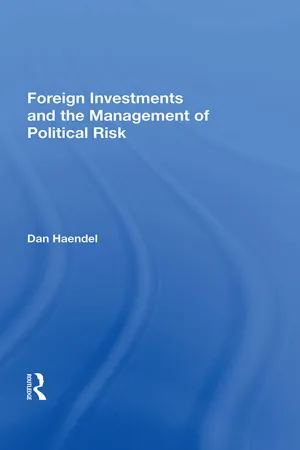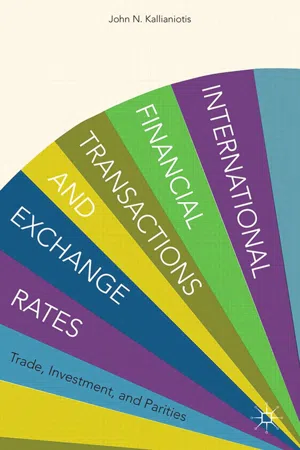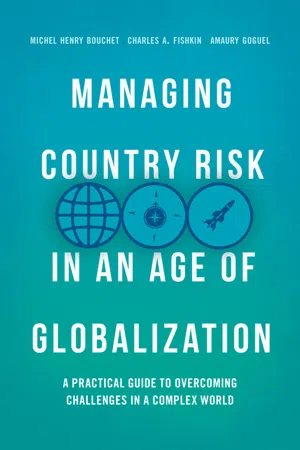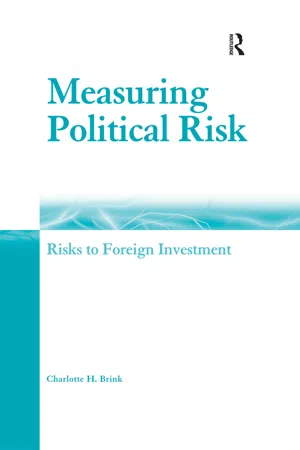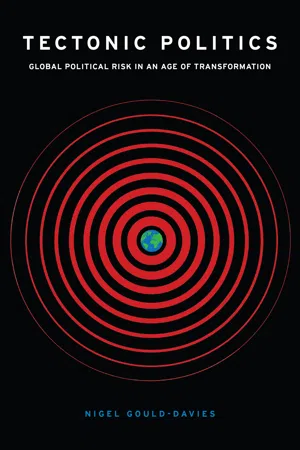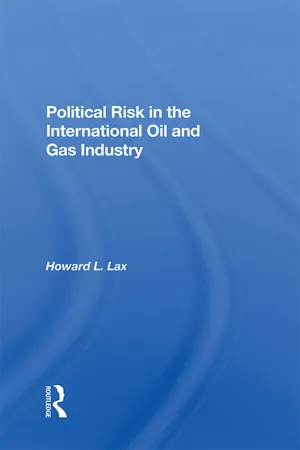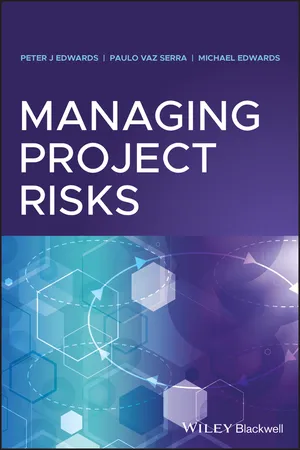Business
Political Risk
Political risk refers to the potential impact of political decisions, events, or conditions on business operations and investments. This can include changes in government policies, regulations, or instability in a country's political environment. Political risk can affect a company's profitability, market access, and overall business stability. It is a key consideration for businesses operating in international markets.
Written by Perlego with AI-assistance
Related key terms
Related key terms
1 of 4
Related key terms
1 of 3
11 Key excerpts on "Political Risk"
- eBook - ePub
Rethinking Political Risk
Concepts, Theories, Challenges
- Cecilia Emma Sottilotta(Author)
- 2016(Publication Date)
- Routledge(Publisher)
laissez-faire government has lost much of its appeal to business theory and practice.The third definition is perhaps the most precise from the semantic point of view, because it rightly considers Political Risk not simply in terms of events but rather in terms of the likelihood of events (harmful to an MNE’s operations). If the aspect of probability calculation is overlooked, by conceptualizing Political Risk in terms of mere ‘events’ which can have an impact on a firm,6 one might end up behaving like the proverbial fool who, when a finger is being pointed at the moon, only looks at the finger. Political Risk calculation is an intrinsically forward-looking task (on this point, see Chapter 2 ), and Political Risk may well be structurally high, and be perceived as such by a firm, even in the current absence of possibly harmful events.The fourth category of definitions is broader, since it focuses on the business environment rather than on the individual firm. The influential definition provided by Robock (1971) deserves a closer look:Political Risk in international business exists (1) when discontinuities occur in the business environment, (2) when they are difficult to anticipate, (3) when they result from political change. To constitute a risk these changes in the business environment must have a potential for significantly affecting the profit or other goals of a particular enterprise(p. 7)The idea of an existing, observable discontinuity in the business environment is quite common in definitions of Political Risk. Once again, it is important to underscore a point: even situations which apparently look stable – and that have been so for a relatively long time – may in fact be extremely risky. The notion of latent variables in statistics effectively illustrates this concept.7 Risk can be thought of as the likelihood of a certain event taking place. What is subsequently observed is, in fact, a binary outcome: either the event does take place or it does not. The idea behind latent variables is that they are generated by an underlying propensity for a particular event (say, a general strike, a revolution or a mere act of expropriation) to occur. The political scenario in a country may look stable because it actually is stable, or, paradoxically, it can look stable in a given moment notwithstanding the fact that the political regime in force is about to collapse. A quite effective example thereof can be provided by recalling that, on December 31, 1977, President Carter famously toasted the Shah of Iran for representing “an island of stability in one of the more troubled areas of the world” (Carter, 1977). In the wake of the subsequent and unforeseen Iranian revolution and of the Soviet invasion of Afghanistan, however, PR analysts and scholars such as Brewers had to acknowledge the fact that “the past stability of an authoritarian regime should not be taken as a predictor of future stability” (Brewers, 1981, p. 8). This lesson has proved valid also for the Middle East and North Africa (MENA) countries which experienced drastic political change in the form of revolution in early 2011 (on the Arab Spring as a PR case study, see Chapter 3 - Dan Haendel(Author)
- 2019(Publication Date)
- Routledge(Publisher)
my firm?”Although identifying the sources of “Political Risk,” Franklin Root skirts the problem of definition. He notes that a company investing abroad faces “a wide spectrum of Political Risks that are generated by the attitudes, policies, and overt behavior of host governments and other local power centers such as rival political parties, labor unions, and nationalistic groups.”14Greene defines Political Risk as “that uncertainty stemming from unanticipated and unexpected acts of governments or other organizations which may cause loss to the business firm.”15 This definition of Political Risk assumes loss to the business enterprise, but, as pointed out earlier, the definition advanced here includes the possibility of loss but also the opportunity for gain.These varying definitions of the same term obviously suggest that there is considerable ambiguity, if not confusion, over what Political Risk is. Clearly, the distinction has not been made between the probability of occurrence of an undesired political event(s) and the uncertainty generated by inadequate information concerning the occurrence of such an event(s). Yet this distinction, which some have termed an objective as opposed to a subjective risk estimate, is crucial to Political Risk assessment.Knowledge of the political environment in which the business operates or will operate can reduce the uncertainty involved in decisions about overseas investment. Although the processing of the information is unquestionably subjective, this knowledge allows the businessman to make better calculations regarding the probability that certain types of undesirable political events will occur. Moreover, the businessman should also be monitoring political events that would allow his firm to undertake profitable ventures. The isolation and identification of political factors that can adversely or positively affect the foreign investor is a difficult task, which must be followed by the equally difficult task of measuring and aggregating these factors in a manner allowing for forecasting. If the businessman considering an investment overseas wants knowledge of comparative Political Risk across countries, he encounters the additional methodological problem of standardizing risk estimates across political systems.- eBook - ePub
International Financial Transactions and Exchange Rates
Trade, Investment, and Parities
- I. Kallianiotis(Author)
- 2013(Publication Date)
- Palgrave Macmillan(Publisher)
Kobrin argues that most Political Risk problems of MNCs involve micro risks, which means that there are operational reasons of the foreign firm and not ownership for the host country government to intervine. Political Risk is faced by investors, MNCs, and governments and can be understood and managed with reasoned foresight and appropriate investment. Broadly defined, Political Risk refers to the complications foreign businesses and governments may face as a result of what are commonly referred to as political decisions or “any political change that alters the expected outcome and value of a given economic action by changing the probability of achieving business objectives,” as Kennedy (1988) mentioned.” Political Risk faced by firms can be defined as “the risk of a strategic, financial or personnel loss for a firm because of such nonmarket factors as macroeconomic and social policies (fiscal, monetary, trade, investment, industrial, income, labor, and developmental), or events related to political instability (terrorism, riots, coups, civil war, and insurrection).” 1 Portfolio investors may face similar financial losses, too. Moreover, governments of small and powerless countries may face complications in their ability to execute diplomatic, social, educational, religious, or other initiatives as a result of Political Risk. Sometimes, a low level of Political Risk in a given country does not necessarily correspond to a high degree of political freedom. Indeed, some of the more stable states for many years were also the most authoritarian (e.g., the “Arab Spring” movement). 2 Long-term assessments of Political Risk must account for the danger that a politically oppressive environment is only stable as long as top-down control is maintained, and citizens are prevented from a free exchange of ideas and goods with the outside world. There are many examples of this kind of political environment in Middle East and North Africa countries - eBook - ePub
Managing Country Risk in an Age of Globalization
A Practical Guide to Overcoming Challenges in a Complex World
- Michel Henry Bouchet, Charles A. Fishkin, Amaury Goguel(Authors)
- 2018(Publication Date)
- Palgrave Macmillan(Publisher)
This limited scope ignores the fate of importers and exporters, consultants, contractors, and NGOs, as well as domestic economic agents who are also exposed to Political Risk in their own country. In addition, the restricted focus of this definition reduces the consequences of Political Risk to financial losses only. However, other manifestations of Political Risk are bureaucracy, bad governance, abrupt regulatory changes, opacity, institutional deficiencies, or even crimes and kidnapping. 9.2 Defining Political Risk Whereas political uncertainty refers to instability and threats in the sociopolitical system, Political Risk is the unexpected unfavorable consequences of the arbitrary exercise of power by a government or by nongovernmental actors (including its domestic and foreign ramifications). Overall, political uncertainty stems from a deficit of information and economic intelligence regarding a specific Political Risk. As discussed in Chapters 1 and 2, uncertainty is subjective as the assessment of the likelihood of a specific event depends on diverse perceptions as well as previous experience and risk exposure. Risk, in turn, represents a single outcome associated with a specific event. Exchange rate overvaluation triggers uncertainty whereas a central bank’s devaluation triggers risk. The threat of a general strike generates uncertainty whereas roadblocks and urban guerrillas create risk. A careful information-based analysis will thus transform the assessment of uncertainty into the assessment of risk, thereby creating the basis for risk mitigation strategies, such as reduced exposure or insurance. Unexpected discontinuities that occur in the sociopolitical system can result in a wide range of consequences depending on the specific exposure of domestic versus foreign economic agents. A risk matrix is therefore required to link exposure, timing, and risk as precisely as possible - eBook - ePub
Measuring Political Risk
Risks to Foreign Investment
- Charlotte H. Brink(Author)
- 2017(Publication Date)
- Routledge(Publisher)
Chapter 6Managing Political RiskIntroduction
Investors put assets at risk to achieve their objectives and the analysis of these risks, including Political Risks, is a key to successful operations. Weighing up opportunities against potential losses becomes possible after an initial Political Risk assessment. Of course, the nature of risks an investor might face depends upon the project; the factors present in a host country’s investment climate that are associated with the project; cultural prevalence; and the individuals that make up the organization. Opportunities and risks are often a double-edged sword, and the management of Political Risks is but one of the challenges a Multinational Company (MNC) faces in a host country.A firm’s foreign investment strategy deals with the positioning of the organization in an uncertain host country environment and investment climate. As such, organizational strategic choices determine the size of a firm’s exposure to uncertain environmental and organizational components that impact on company performance. This chapter will attempt to explain how a firm’s Political Risk exposure (the sensitivity of a firm’s projected profitability and operationability in a host country to changes in the investment climate) can be managed and reduced.Formulating and designing a Political Risk policy as a means of managing Political Risk is a key point in this chapter. So far in this book, a lot of time has been spent on identifying, analyzing and measuring Political Risk. These are very important to any investor in finding the most viable investment opportunity and being aware of the Political Risks involved. Now that it has been shown that this can indeed be established, an investor can make decisions based on the ways in which the Political Risks in a chosen investment environment can be curbed or minimized, if not avoided. - eBook - ePub
Country Risk Analysis
A Handbook
- Ronald L. Solberg(Author)
- 2002(Publication Date)
- Routledge(Publisher)
6 Political-risk analysis for international banks and multinational enterprises
Jeffrey D.Simon
INTRODUCTION
Political Risk has long been an important consideration in international business decisions. Although there is no consensus as to the exact definition of Political Risk, there is agreement on the types of situations that involve Political Risk. Basically, Political Risk refers to those political and social developments that can have an impact upon the value or repatriation of foreign investment or on the repayment of cross-border lending. These developments may originate either within the host country, in the international arena, or in the home-country environment.Early conceptual and analytical work conducted in the 1960s and 1970s focused on how to assess the effect of non-economic variables upon foreign investment.1 It was not until the early 1980s, however, that the political-risk industry was formally launched. Revolutions in Nicaragua and Iran at the end of the 1970s caught many international banks and multinational enterprises (MNEs) off guard. The large financial losses associated with radical regime changes in both countries clearly demonstrated the importance of political events in host-country environments.Yet expectations about what political-risk analysis could accomplish exceeded the emerging profession’s capabilities. This was the fault mainly of the advocates of the new discipline. Many in the business community remained skeptical about what political analysis could really deliver for assessing financial and economic investments. For professional business analysts and decision-makers accustomed to ‘hard’ data on economic and financial trends, the political world represented uncertain subjective terrain. Political-risk analysts, however, ranging from individual entrepreneurs to large consulting services, offered their expertise to international banks and MNEs and in the process raised unrealistic expectations. This included leaving the impression that, with the right methodological framework or well-placed contacts, Political Risk in a given country could be accurately forecast. - eBook - ePub
Tectonic Politics
Global Political Risk in an Age of Transformation
- Nigel Gould-Davies(Author)
- 2019(Publication Date)
- Brookings Inst. Press/Chatham House(Publisher)
2Today, the situation is fundamentally different. PwC’s 2018 global survey of chief executive officers (CEOs) found that five of the top eight risks that CEOs are “extremely concerned” about are political. It concluded thatCEOs across the world are increasingly anxious about broader societal threats—such as geopolitical uncertainty, terrorism, and climate change—rather than direct business risks such as changing consumer behaviour or new market entrants.3But while the significance of global politics for markets is escalating, the capacity to manage its impact is declining. As a consequence, even though all aspects of business have grown in complexity, the challenges that politics create have risen more than any other traditional source of risk.4 This chapter explores three questions:- How has Political Risk evolved?
- Why has Political Risk proved so difficult to understand and engage?
- How can Political Risk be better understood and engaged?
All of life carries risk, and economic activity is a part of life. Where market actors face risks that are infrequent, low impact, or manageable, they can create value through production and exchange. But frequent, severe, or unmanageable risks will hinder value creation. Production and exchange themselves always carry risks, including process integrity, safety, and changes in price and demand. Such risks are intrinsic : it is impossible to imagine production and exchange taking place without them. They can be better managed or mitigated over time—many have fallen significantly—but never eliminated entirely.5 Production and exchange face extrinsic - eBook - ePub
- Robert McKellar(Author)
- 2017(Publication Date)
- Routledge(Publisher)
A useful conclusion to this chapter is a consideration of the concept of a Political Risk management strategy. Thus far we have considered specific measures and the structures that can be built to implement them, but we should not fall into the trap of thinking about the issue in terms of a series of reactive stopgaps. Political Risk can be dealt with strategically, and every company needs to shape its approach in the context of its business aspirations and unique corporate culture.A Political Risk management strategy can be defined as a company’s unique long-term approach to dealing with Political Risk. It provides the parameters that shape our approach to risk in any given context. The strategy consists of the balance between the four main Political Risk management measures (portfolio management, security, relationship-building and risk transfer), and aligns our approach to risk with our international growth strategy and desired corporate identity.Take, for example, two international construction companies. One of them aggressively pursues opportunities wherever they arise, and it sees itself as hard-headed, practical and fiercely competitive. The company seeks maximal agility and maintains the lowest possible overheads. Its strategy for Political Risk reflects its character and ambitions. The firm transfers as much risk as possible to insurers and partners, and outsources all security and risk intelligence to a major international supplier. In operations, it insists that expat personnel remain on secured sites and minimise interaction with the host community to reduce exposure as much as possible. The firm allocates only enough to CSR to directly offset its own negative effects on host communities, and generally handles CSR by providing lump sum donations to local NGOs, rather than taking an active role in CSR planning. The company regards its success as a business to be its principal value to society, and carefully controls expectations of its social performance. This formula has worked, and enables the agility which is core to the company’s strategy. - Howard L Lax, Calvin Goldscheider(Authors)
- 2019(Publication Date)
- Routledge(Publisher)
The Multinational Enterprise in Transition, ed. A. Kapoor and Phillip D. Grub (Princeton: Darwin Press, 1972). Copyright 1972 The Darwin Press.country will inhibit the occurrence of "risk events" (not specifically defined by Johnson), as will insufficient host power.Figure 6.4 Johnson's Model of Political Risk SOURCE: Howard Johnson, Risk in Foreign Business Environments: A Framework for Thought and Management (Cambridge, Mass.: Arthur D. Little, 1980).The logic of the Johnson model is far more explicit than that of Root's scheme. The flow of relationships is more specific and more variables are detailed, although the components of development (political, social, and so on) tend to be aggregate concepts. The model provides one way to see the origins and causes of risk in a more than rudimentary manner.The Political Risk technique developed by D.W. Bunn and M.M. Mustafaoglu (specifically designed for oil firms investing abroad) employs an implicit model of Political Risk.13 Although the authors do not present a specific model per se, they identify the independent variables that may give rise to several types of Political Risks (dependent variables). The occurrences of ten "Political Risk events," outcomes that "would have a negative impact on the success of the venture," are determined by "Political Risk factors," those "circumstances which influence the occurrence of a Political Risk event."14 The interrelationships between Political Risk factors are not specified, although we can presume that such interrelationships exist because of overlapping between factors. Moreover, the authors indicate that the list includes only some of the major influencing Political Risk factors. The prose model devised by Bunn and Mustafaoglu is presented in table 6.1 .More than in the other models reviewed, Bunn and Mustafaoglu specify the dependent variables in a way that has a direct meaning for foreign firms. The single vectors we have implied (Political Risk factors → Political Risk events) do not do full justice to the authors' framework. In addition to missing the interrelationships be tween risk factors, it also fails to take into account the cross-impact probabilities be tween risk events.15- eBook - ePub
- (Author)
- 2023(Publication Date)
- Wiley(Publisher)
Event risk evolves around set dates known in advance. Political events, for example, often result in changes to investor expectations related to a country’s cooperative stance. Brexit is an example of event risk.Exogenous risk is a sudden or unanticipated risk that can affect either a country’s cooperative stance, the ability of non-state actors to globalize, or both. Examples include sudden uprisings, invasions, or the aftermath of natural disasters.- Thematic risks are known risks that evolve and expand over time. Climate change, cyber threats, and the ongoing threat of terrorism fall into this category.
- To make an assessment, an investor considers geoPolitical Risk in terms of the following three areas:
- likelihood it will occur,
- velocity (speed) of its impact, and
- size and nature of that impact.
GeoPolitical Risks seldom develop in linear fashion, making it difficult to monitor and forecast their likelihood, velocity, and size and nature of impact on a portfolio. As a result, many investors deploy an approach that includes scenario building and signposting rather than a single point forecast.Investors study geoPolitical Risk because it has a tangible impact on investment outcomes. On a macroeconomic level, these risks can affect capital markets conditions, such as economic growth, interest rates, and market volatility.- Changes in capital markets conditions can have an important influence on asset allocation decisions, including an investor’s choice of geographic exposures.
- On a portfolio level, geoPolitical Risk can influence the appropriateness of an investment security or strategy for an investor’s goals, risk tolerance, and time horizon.
2. National Governments and Political Cooperation
Learning Outcome
The candidate should be able to:- ☐ describe geopolitics from a cooperation versus competition perspective
The international environment is constantly evolving. Such trends as the growth of emerging market economies, globalization, and the rise of populism affect the range of opportunities and threats that companies, industries, nations, and regional groups face. Geopolitics - eBook - ePub
- Peter J. Edwards, Paulo Vaz Serra, Michael Edwards(Authors)
- 2019(Publication Date)
- Wiley-Blackwell(Publisher)
For the great majority of Political Risks, qualitative analysis is the only feasible technique, since the nature of any ‘hard’ data, even if they can be collected, will rarely be appropriate for any reliable quantitative assessment. In any event, if political influence is already being exerted over the project, there is no uncertainty about its likelihood of occurrence – only about the potential impact. If nothing political has happened so far, then the probability of a Political Risk occurring is essentially a judgement call for the project stakeholder and will depend on perceptions of the likely source and nature of the event.Nor is there much advantage gained by trying to quantify the impact precisely. Other than possible delays to the project, other impacts may be more intangible in relating to difficulties and barriers rather than to direct effects on project costs. Political Risks, if they eventuate, more often than not lead to disruption and turbulence. Both are difficult, if not impossible, to assess reliably and confidently in terms of their magnitude.For example, the promoter of a new ‘fracking’ project to extract natural gas from a rural underground location using high‐pressure water injection might foresee the likelihood that an environmental or agricultural lobby group will carry out some form of protest action to threaten the project itself or the extraction rights approval processes of the responsible authority. The uncertainties associated with this form of Political Risk will relate to questions such as: What group(s), when, where, how often, what form, what intent, and what direct and indirect impacts? Protest actions that occurred in the past may provide only limited and unreliable guidance, since the strategy of most protest groups is to achieve their objectives in radical and news‐grabbing ways that will garner public support or attention.Furthermore, it is not safe to assume that Political Risk activity will always happen in the upfront stage of the project cycle. Many ‘landmark’ projects have been associated with politically based risk events at their opening ceremonies. Others have been similarly affected at key milestone points as opposition forces gather strength and momentum and as such points become newsworthy.
Index pages curate the most relevant extracts from our library of academic textbooks. They’ve been created using an in-house natural language model (NLM), each adding context and meaning to key research topics.
Explore more topic indexes
Explore more topic indexes
1 of 6
Explore more topic indexes
1 of 4

